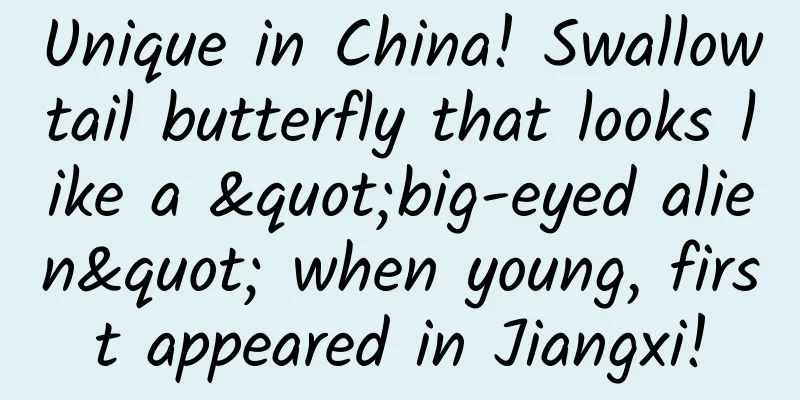Unique in China! Swallowtail butterfly that looks like a "big-eyed alien" when young, first appeared in Jiangxi!

|
In the colorful world of butterflies, there is a world-class rare butterfly that is particularly special and is only found in China. The larva of this butterfly looks like a caterpillar, but has a "snake head", a pair of huge "panda eyes", snail-like tentacles around its mouth, and "leopard spots" all over its body, just like a "big-eyed alien". Recently, researchers from the Institute of Forest Ecology, Environment and Nature Conservation of the Chinese Academy of Forestry discovered this butterfly at the Dagangshan Forest Ecosystem National Field Scientific Observation and Research Station in Xinyu, Jiangxi Province. This is the first time this rare species has been recorded in this area. Its scientific name is Papilio serrata, also known as the large-tailed Papilio serrata and the Chinese broad-tailed Papilio serrata. The symbol of Chinese butterflies The Swallowtail butterfly is one of the oldest species in the world. According to zoological history, the Swallowtail butterfly came from the Ice Age, millions of years ago. In 1889, the Swallowtail butterfly was discovered in my country by a British zoologist and is a species unique to China. In my country, the broad-tailed swallowtail butterfly is only distributed in Sichuan, Shaanxi, Hubei, Guangdong, Guangxi and other places. Its habitat is deep mountains and dense forests where few people go. It usually appears in mountainous areas at an altitude of 700-1800 meters, and it especially likes to move in sunny landslides. The broad-tailed swallowtail butterfly is black all over, and its wings usually have golden scales, which are brightly colored. The wingspan is about 115-130 mm. The wings are flat when resting, and the hind wings do not flap when flying. It is good at gliding and has the habit of climbing heights. It usually flies to higher places along the terrain and gathers on ridges or peaks. Although the broad-tailed swallowtail butterfly flies slowly, it is rare and graceful, so it is also called the "dream butterfly" and is regarded as a symbol of Chinese butterflies by the international academic community. A broad-tailed swallowtail butterfly once appeared in a scenic spot in Longhui County, Hunan Province, and tourists who were lucky enough to see it at the time praised it for its "dreamlike" flight. Among all butterflies in the world, the Broadtail Swallowtail has a unique feature that other swallowtail butterflies do not have: two wing veins running through the wide tail-like protrusion. This is why the Broadtail Swallowtail is world-famous. The "Master of Camouflage" in the Insect World Usually, the reproduction of the broad-tailed swallowtail butterfly occurs twice a year, and a few have one generation a year. In one generation, it goes through 8 different evolutionary stages, of which there are up to 5 larval stages, 2 cocoon pupae stages, and the remaining 1 is the adult stage. Because it is rare, the life of the Swallowtail Butterfly is particularly "unique". From its childhood, its life changes in thousands of ways in order to avoid enemies and camouflage itself in various forms to ensure successful evolution. It is known as the "big-eyed alien" who can transform into 72 different forms. Especially when it is a fifth-instar larva, the "big-eyed alien" actually "transforms" itself into a venomous snake. Although it is short, its "big head" occupies one-third of its body. When there is an enemy, it will spit out its snake-like Y-shaped tongue - antennae, imitate a snake spitting out its tongue, and emit an unpleasant smell, and make an attacking posture like a snake to intimidate or repel the enemy. According to the evolutionary stage, the broad-tailed swallowtail butterfly will disguise itself as bird droppings in its early stages, attaching its yellow-white and gray-brown body to the leaves to avoid being preyed upon by its natural enemies. When it enters the pupa stage, it will disguise itself as a dead branch and hang on it to avoid being discovered by its natural enemies. When it reaches the adult stage, it no longer needs to imitate other animals or plants, but immediately transforms into one of the most stunning members of the swallowtail butterfly. In addition to camouflage skills, the broad-tailed swallowtail butterfly has some special behaviors and habits in life. For example, when the larvae are frightened, they will turn out their stink glands and inflate their three thoracic segments into a triangle, forming an intimidating posture for self-defense. (The author Xu Huangang is a member of the China Science Writers Association) |
<<: Enoki mushrooms, Chinese cabbage, etc. are all formaldehyde vegetables and cannot be eaten?
Recommend
Your analysis may not be correct. Logical reasoning has many traps.
[[149777]] People like to use a single chain of l...
Framework learning: downloading AOSP source code and compiling in detail
1. Preparation Android officially announced that ...
What are the functions of the Lanzhou early childhood education mini program? How much does the early childhood education center mini program cost per year?
"I hope my son will become a dragon and my da...
Don’t worry about AI eating up your job. It may be the software itself that’s eating up your job.
summary There is a great deal of hype about recen...
Mr. Fengkou-Wudao Pavilion (Small Circle)
Mr. Fengkou-Wudao Pavilion (small circle) resourc...
What does Douyin’s natural traffic mean? How to improve?
Nowadays, there are many people playing Douyin . ...
Summary of App Store review of financial apps 3.2.1 rejection and 23 other reasons
In recent years, the financial industry has been ...
Get the LaunchImage of the app
[[153741]] The management of LaunchImage is actua...
Data Thief: How were Xiaomi and Pinduoduo’s e-commerce data sold to Wall Street?
Just before Xiaomi went public, a Chinese fund ma...
Analysis of isolated storage mechanism in Windows Phone 8
【51CTO translation】The role of the isolated stora...
"WHO reminds people to avoid using ibuprofen when dealing with COVID-19?" Don't be misled by outdated information!
Recently, a piece of news released in 2020 has on...
Toutiao account operation guide!
How to place advertisements on Toutiao? How to op...
New broadband players may disrupt the pricing structure
The broadband market has become less peaceful sin...
Latest research: Sunbathing can prevent dementia! But too much or too little sun exposure can cause dementia!
The team led by Professor Yu Jintai from Huashan ...


![[Popular Science of Chinese Military Technology] How can “smart” AI improve the accuracy of intelligent aiming in combat?](/upload/images/67f2291bc791c.webp)






